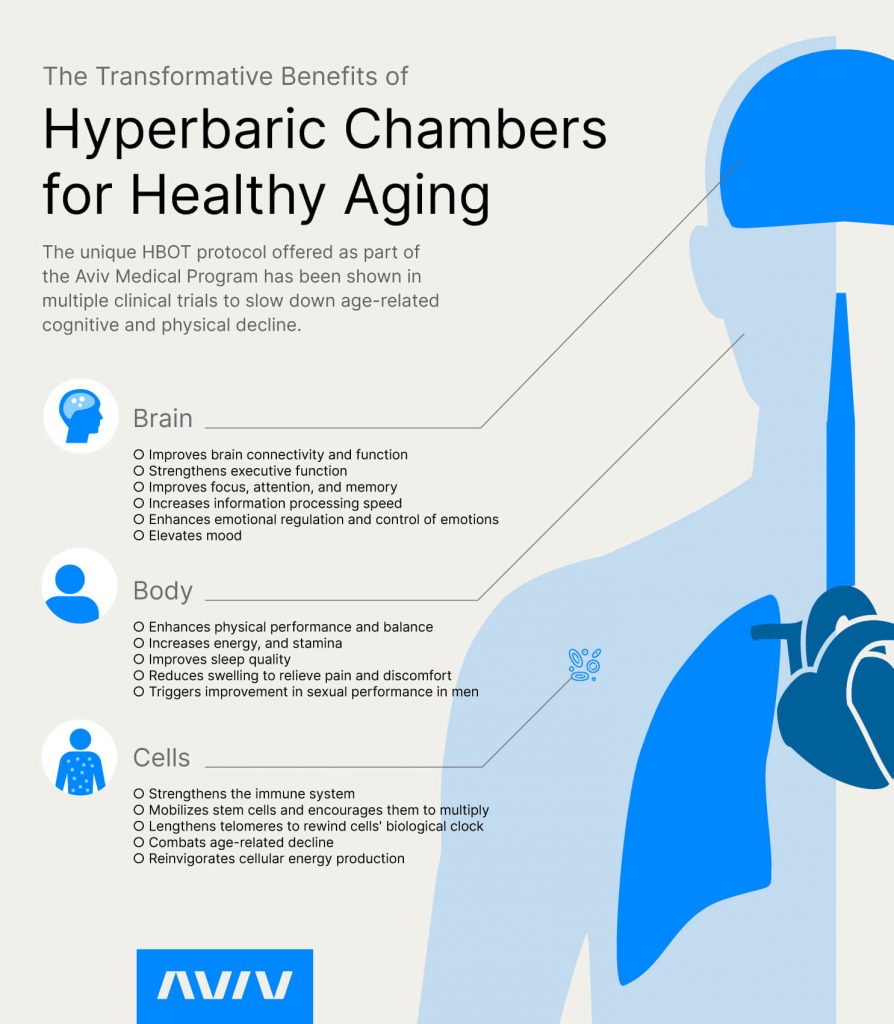
How to Increase Blood Oxygen Level: 21 Tips for Better Oxygenation


Oxygen is essential for human life. It powers our bodies, fuels our brains and keeps us active. For our bodies to function, our cells need energy. Oxygen is the fuel that allows our cells to break down the glucose in our food to create energy. Blood vessels transport oxygen-rich red blood cells throughout our bodies, nourishing our tissues and allowing this process of energy production, or cellular respiration, to occur. If you’re interested in how to increase blood oxygen level for better energy, focus, and health, simple interventions can help you optimize oxygen in your bloodstream.
As we age, oxygen levels can wane. Blood vessels grow narrower, limiting the transportation of oxygen to red blood cells. This is one reason why we might feel physically and cognitively weaker. At Aviv Clinics, we understand that with the right resources and the benefits of more oxygen in your blood, you can move forward confidently, no matter your age.

Understanding Blood Oxygen Levels: How to Increase Blood Oxygenation
Your blood oxygen level (also referred to as blood oxygen saturation) is the amount of oxygen you have in your blood. Two main tests are available to measure your blood oxygen level: pulse oximetry and a blood draw test.
- A normal oxygen level using pulse oximetry (a small device often clipped onto your fingertip) is between 95% and 100%.
- For a blood draw, laboratories have different reference ranges and will have details regarding the normal oxygen range. Reach out to your lab or doctor if you have questions.
Low oxygen levels often indicate:
- Heart conditions
- Lung conditions, such as asthma and bronchitis
- Inflammation
- Sleep apnea
- A high-altitude environment
21 Tips to Naturally Increase Blood Oxygen Saturation
Boosting oxygen levels involves these 21 actionable tips, organized by category.

Exercise to Boost Blood Oxygen Levels
- Cardio: Cardio exercises increase your breathing rate, which helps you absorb more oxygen.
- Stretching: Stretching helps your muscles receive more blood, oxygen, and nutrients.
- Maintain a healthy weight: Excessive weight can strain the respiratory system and reduce lung capacity. Keeping a healthy weight can improve lung function and increase blood oxygen levels.
Foods That Increase Blood Oxygen for Better Health
What foods increase oxygen in the blood? To enrich your oxygen levels through a healthy diet, you should:
- Consume dark leafy greens: Leafy greens such as kale and spinach increase blood oxygen. They contain nitrogen, which “plays a major role in delivering oxygen throughout the body.”
- Incorporate iron-rich foods: Foods like white beans, tofu, and dark chocolate contain iron, an “essential element for blood production.”
- Snack on antioxidant-rich fruits: Fruits like blueberries and cranberries are high in antioxidants, which promote blood flow and provide more oxygen to tissues.

Improve Oxygen Flow by Maintaining Good Posture
- Stand or sit up straight: Research notes “the best oxygenation [is] in the ‘sitting upright’ position.” Lying down for a long period can put pressure on your lungs. Take the time to stand or sit up straight to help increase lung capacity.
How to Increase Oxygen in Blood Through Healthy Lungs
- Drink plenty of water: Well-hydrated lungs are more efficient at dispersing oxygen into your bloodstream. The average daily water intake for “men is about 15.5 cups and for women, about 11.5 cups.”
- Go outside: There’s nothing like a breath of fresh air to promote more oxygen flow. Not to mention, you’ll also get to take in the sunshine and some vitamin D!
Deep Breathing Techniques to Elevate Blood Oxygen Saturation
- Diaphragmatic breathing: Also called belly breathing, diaphragmatic breathing provides positive oxygenation effects.
- Sit up straight, one hand on your stomach, the other on your chest.
- Breathe slowly through the nostrils. In addition to your chest rising, you should also feel your stomach area expand with each full, diaphragmatic breath.
- Exhale slowly through your mouth.
- Repeat six or more times per minute for up to 15 minutes.
Reduce Toxins to Maximize Blood Oxygen Levels
- Get indoor plants: House plants help remove organic chemicals in the indoor air.
- Set up an air purifier: An air purifier helps trap dust, pollen, and bacteria and disperses clean air back into your home.
- Choose electric over gas: For example, you may opt for an electric stove rather than a gas stove to avert indoor pollution.
- Quit smoking: Smoking has a detrimental effect on oxygen circulation. Make a plan to quit smoking and avoid second-hand smoke.

Sleep Habits that Support Healthy Blood Oxygen
- Stay consistent with your sleep schedule: Being well-rested is vital for maintaining healthy oxygen levels. Get up and go to bed at the same time each night. This consistency reinforces your body’s sleep-wake cycle.
- Limit naps: While sleeping during the day makes up for lost sleep, long naps might make it harder for you to fall asleep at night.
- Stay clear of caffeine: The general rule of thumb is to have a caffeine cut-off time of a “minimum of eight hours before bedtime.”
- Regulate bedroom temperature: An environment that is too hot or too cold is not conducive to good sleep. Keep your bedroom at a cool, but comfortable temperature.
Stress Reduction Tips for Better Oxygenation
- Connect with loved ones: When we feel stressed, our breathing becomes shallow. This inhibits healthy oxygen flow to the bloodstream. Reaching out to trusted friends and family members can help you feel supported and more grounded.
- Take on a hobby: A new hobby, such as crocheting, baking, or writing, can offer a healthy distraction and put your mind at ease.
- Seek therapy: Therapy offers a safe space to voice and process your concerns and discover healthy coping mechanisms.
Hyperbaric Oxygen Therapy (HBOT): A Medical Method to Increase Blood Oxygen Level

All the above tips are good to implement on a day-to-day basis, but when you feel age-related decline coming on, additional measures might be needed.
Hyperbaric oxygen therapy (HBOT) is a significant way to help increase your blood oxygen levels. HBOT is a medical procedure that involves breathing 100% oxygen in a pressurized chamber. Research has shown that breathing oxygen in a pressurized environment improves circulation and allows more oxygen to be absorbed into the bloodstream.
Aviv Clinics uses a unique, specialized HBOT protocol inside its state-of-the-art hyperbaric suites, which includes precise fluctuations of oxygen levels during each HBOT session.

This specific HBOT protocol not only elevates levels of oxygen in the body, but also encourages your body to unlock its self-healing mechanisms.
Thanks to the biological progressions HBOT offers, the Aviv Clinics’ medical team has been able to help patients better manage conditions such as age-related concerns, traumatic brain injuries and stroke.

Take Charge: Boost Your Blood Oxygen for Overall Health and Well-being
Boosting your blood oxygen levels is an effective way to support energy, focus, and overall wellness. You can start today by incorporating the practical tips outlined here, then take your results even further with the Aviv Medical Program. Our comprehensive health assessments, evidence-based hyperbaric oxygen therapy protocol, and complementary therapies are designed to help you maximize oxygen delivery, enhance circulation, and stimulate your body’s self-healing potential.
Schedule a free consultation with our board-certified physicians to discover how the personalized Aviv Medical Program can support your brain, body, and overall health.
Last Update: November 26, 2025



